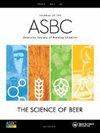Malting Quality of ICARDA Elite Winter Barley (Hordeum vulgare L.) Germplasm Grown in Moroccan Middle Atlas
IF 1.8
4区 农林科学
Q4 BIOTECHNOLOGY & APPLIED MICROBIOLOGY
Journal of the American Society of Brewing Chemists
Pub Date : 2021-10-11
DOI:10.1080/03610470.2021.1978036
引用次数: 5
Abstract
Abstract The use of barley (Hordeum vulgare L.) in Morocco is still limited to food and feed despite the amplified demand by local industries for imported malt. This study aims to evaluate 36 barley elite lines for major grain physicochemical parameters and malt quality traits. Analysis of variance, Pearson correlation, principal component analysis (PCA), and hierarchical cluster analysis (HCA) were performed. The results showed significant genotypic variation among genotypes for individual grain and malt traits. High broad sense heritability was obtained for all traits except for plump grain percentage, malt friability, and germination capacity. Starch, malt extract, Kolbach index, grain area, and test weight correlated significantly and negatively with barley protein. Malt extract correlated positively with Kolbach index and starch, but a negative correlation with soluble protein and malt protein was found. Based on 12 characters, 77% of the total genotypic variation was explained by the three first principal components following PCA and four clusters were depicted based on HCA. Genotypes of high interest with desirable levels of quality standards were identified to be used as a malt quality traits donor while designing crossing programs. Supplemental data for this article is available online at https://doi.org/10.1080/03610470.2021.1978036 .摩洛哥中图集ICARDA优质冬大麦(Hordeum vulgare L.)种质的麦芽品质
大麦(Hordeum vulgare L.)在摩洛哥的使用仍然局限于食品和饲料,尽管当地工业对进口麦芽的需求扩大。本研究旨在对36个大麦优良品系的主要籽粒理化参数和麦芽品质性状进行评价。进行方差分析、Pearson相关分析、主成分分析(PCA)和层次聚类分析(HCA)。结果表明,籽粒和麦芽性状各基因型间存在显著的基因型差异。除饱满粒率、麦芽脆性和发芽率外,其余性状的广义遗传力均较高。淀粉、麦芽浸出物、科尔巴赫指数、粒面积、试重与大麦蛋白呈极显著负相关。麦芽提取物与科尔巴赫指数和淀粉呈显著正相关,与可溶性蛋白和麦芽蛋白呈显著负相关。基于12个性状,77%的总基因型变异由PCA后的3个前主成分解释,基于HCA描述了4个聚类。在设计杂交方案时,确定了具有理想质量标准的高兴趣基因型作为麦芽质量性状供体。本文的补充数据可在https://doi.org/10.1080/03610470.2021.1978036上在线获得。
本文章由计算机程序翻译,如有差异,请以英文原文为准。
求助全文
约1分钟内获得全文
求助全文
来源期刊

Journal of the American Society of Brewing Chemists
工程技术-生物工程与应用微生物
CiteScore
4.00
自引率
20.00%
发文量
41
审稿时长
3 months
期刊介绍:
The Journal of the American Society of Brewing Chemists publishes scientific papers, review articles, and technical reports pertaining to the chemistry, microbiology, and technology of brewing and distilling, as well as the analytical techniques used in the malting, brewing, and distilling industries.
 求助内容:
求助内容: 应助结果提醒方式:
应助结果提醒方式:


